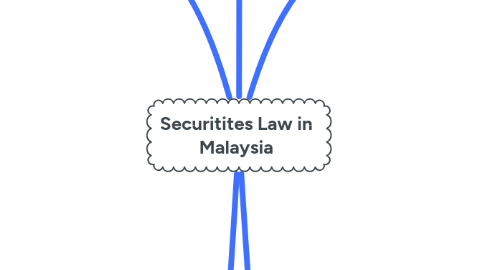
1. 1. Securities Comission Malaysia Act 1993 (SCA)
1.1. Regulatory Framework & Power
1.1.1. Establishes Securities Comission Malaysia (SC)
1.1.2. Functions:
1.1.2.1. Regulates and supervise and futures markets
1.1.2.2. Register and license market participants
1.1.2.3. Develop capital markets
1.1.2.4. Advise government on capital market matters
1.1.3. SC as a regulator for capital markets
1.2. Obligations of Market Participants
1.2.1. Companies
1.2.1.1. Timely and accurate disclosure of financial information
1.2.1.2. Compliance with corporate governance standards
1.2.2. Intermediaries (Brokers, fund ) managers,etc.
1.2.2.1. Obtain and maintain licenses
1.2.2.2. Adhere to fit and proper criteria
1.2.2.3. Implement internal controls and risk management
1.2.3. Auditors
1.2.3.1. Comply with auditing standards
1.2.3.2. Subject to AOB oversight
1.3. Enforcement Provisions
1.3.1. Powers of investigation, search, and seizure
1.3.2. Administrative sanctions
1.3.2.1. Fines (up to RM500,000 for AOB-related) offenses
1.3.2.2. Public reprimands
1.3.2.3. Suspension or revocation of licenses
1.3.3. Civil remedies (compensation to investors)
1.3.4. Criminal prosecution for serious breaches
1.4. Real-World Case Stud
1.4.1. Example 1: 2021-Audit firm sanctioned by AOB for failure to comply with auditing standards (public reprimand + fine)
1.4.2. Example 2: SC action against company directors for misleading disclosures
1.5. Key Provisions
1.5.1. Licensing of intermediaries (brokers, dealers, fund) managers
1.5.2. Disclosure requirements for public companies
1.5.3. Audit Oversight Board (AOB) to monitor auditors
1.5.4. Oversight of collective investment schemes
2. 3. Application Implication
2.1. Corporate Finance
2.1.1. Companies must comply with disclosure and fundraising rules
2.1.2. Ensures transparency and investor confidence
2.2. Investment Finance
2.2.1. Licensing and conduct rules for fund managers, brokers, and analysts
2.2.2. Investor protection through compensation funds and disclosure
2.3. Securities Trading
2.3.1. Prohibition of market abuse (insider trading,manipulation)
2.3.2. Surveillance and enforcement by SC
3. 2. Capital Markets and Services Act 2007 (CMSA)
3.1. Licensing & Investor Protection
3.1.1. Single licensing regime for all capital market intermediaries
3.1.2. Licensing requirements: fit and proper, capital adequacy, compliance systems
3.1.3. Investor compensation fund
3.1.4. Requirement for client assets to be held in trust accounts
3.2. Key Provisions
3.2.1. Disclosure requirements for prospectuses and continuous reporting
3.2.2. Prohibition of market misconduct
3.2.2.1. Insider trading
3.2.2.2. Market manipulation
3.2.2.3. False trading and price rigging
3.2.2.4. Dissemination of false/misleading information
3.2.3. Rules for collective investment schemes
3.3. Obligations of Market Participants
3.3.1. Companies
3.3.1.1. Accurate and timely disclosures in prospectuses and annual reports
3.3.1.2. Compliance with fundraising regulations
3.3.2. Intermediaries
3.3.2.1. Maintain proper records and segregation of client assets
3.3.2.2. Implement anti-money laundering (AML) procedures
3.3.2.3. Report suspicious transactions
3.3.3. Investors
3.3.3.1. Avoid illegal trading practices (e.g., insider trading)
3.3.3.2. Exercise due diligence when investing
3.4. Regulatory Actions & Penalties
3.4.1. Fines (e.g., RM100,000 for certain) breaches
3.4.2. Disgorgement of illegal profits
3.4.3. Suspension or revocation of licenses
3.4.4. Civil suits for investor losses
3.4.5. Imprisonment (up to 10 years for) some offenses
3.5. Real- world Case Studies
3.5.1. 2023: SC imposed RM19.53 million in fines for 76 breaches (including unlicensed activities, disclosure failures)
3.5.2. 2010: Maybank Investment Management fined RM100,000 for compliance failures
3.5.3. Insider trading cases: Prosecution of individuals for using non-public information
4. 4. Enforcement Mechanism
4.1. Investigations & Audits
4.1.1. SC conducts market surveillance
4.1.2. Investigates suspicious transactions and market conduct
4.2. Administrative Sanctions
4.2.1. Fines, reprimands, license suspensions/revocations
4.3. Civil Remedies
4.3.1. Compensation for investor losses
4.3.2. Disgorgement of illegal gains
4.4. Key Takeaways
4.4.1. Prosecution for serious offenses (e.g., insider trading, fraud)
4.4.2. Imprisonment and heavy fines
